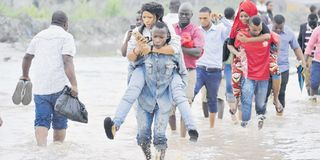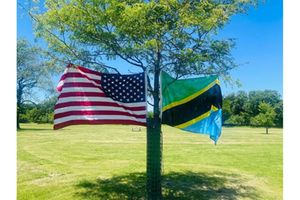Rains have exposed our unpreparedness, again

For some Dar es Salaam youth, floods are a blessing in disguise. They ferry people across flooded areas on their back at a fee of Sh1,000. PHOTO | file
After months of extended drought, heavy rains have arrived. The switching of the two extreme weather events makes life difficult especially for farmers and pastoralists whose activities are highly weather-sensitive.
Power blackouts during droughts as a result of reduced volume of water and during rains due to falling electric poles negatively affect businesses and hamper learning at academic institutions.
Cumulatively, overall repercussions on the economy are direct, enormous and real. Wind erosion that sweeps the top soil granules during dry weather and massive water erosion, avalanches and land erosion are intolerable evils of weather that are recurrent.
The Meteorological Department warns of imminent weather by forecasting, often with reliable degrees of precision. Poverty, a culture of scepticism to scientific warnings and ignoring valuable information always lead to losses of property and deaths that could have been avoided.
As the rains intensify, and without a shred of doubt, weather-sensitive sectors have been adversely affected. Agriculture and transport are the most affected yet majority of the population heavily relies on these sectors in making ends meet.
It is ensconced through research that the two extreme weather events of El Niño and La Niña are concurrent. Climate change scenarios in the last decade that have seen consecutive increases in global temperature than hitherto as a result of increasing emissivity of Green House Gases (GHGs) is a thing to worry about.
When rivers dry up there is hardly water to sustain grass in the rangelands compelling pastoralists to migrate in search of water and pasture. Often, this leads to inter-community aggressions and catalyses human-animal conflicts over resources. It is appalling that neither rain nor dry weather that seems to favour Kenyans and cushion them from hunger and suffering because robust government policies that are conscious of the ever-changing weather, although in place, are not being implemented and although implemented, it is done quite untimely.
The laxity to implement and actualize existing policies that have propensity to reduce losses during extreme weather periods should be re-focused and given utmost attention.
Water harvesting, planting of crops that mature fast and that are drought resilient, and investing in clean energy are some of the measures that can benefit the economy in periods of El Niño or La Niña are some of the additional interventions needed because they are timeless in nature.
The culture of doubting prescient danger makes Kenyans susceptible to preventable risks. Saving in advance and avoiding risk rather than pursuing avenues that can counter the crisis is not only undesirable but an improper use of public resources that only leads to risk mutation and mimicry.
Improvement of the sewerage systems across towns so that clean drinking water does not get contaminated is an important step in protecting the population from common waterborne diseases that are live-threatening and costly to treat.
Many people doubted meteorologists’ warnings that the region would experience heavy rains due to El Nino. Instead, the warning was politicised.
Many made fun of the Meteorological Department and did not heed its warnings and prepare for the rains that are now wreaking havoc in many parts of the country.
Sadly, deaths and destruction have been reported. Many may consider the El Niño rains horrendous, but the real tragedy will be felt after the cessation of the rains that will usher in a period of La Niña.




